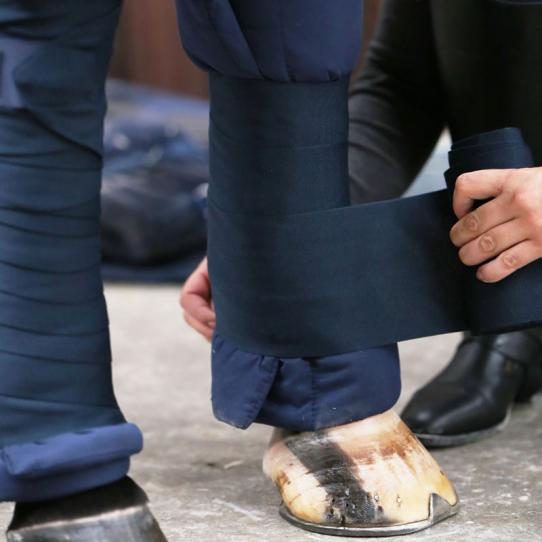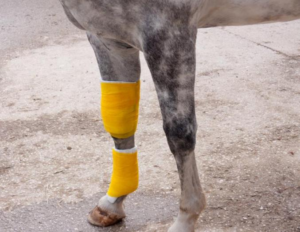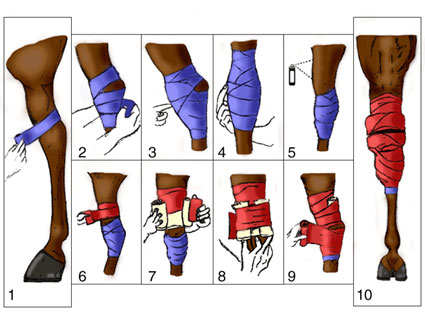In most occasion,wound management in horses can be challenging, time consuming and expensive. Horses and ponies are presented to the veterinary surgeon and nurse with many types of traumatic wounds (Figure 1 and 2). Potential complications can occur depending on the anatomical position, degree of contamination and involvement of important structures such as joints, tendons and nerves, which can have a marked influence on the prognosis. In horses, involvement of joints and other synovial structures is extremely serious because if sepsis of these structures is not controlled with medical or surgical means, then non-weight bearing lameness can necessitate euthanasia. Careful evaluation and correct management of wounds is essential for an optimal result. Most wounds on the body of the horse heal well (Jacobs et al, 1984; Knottenbelt, 1997; Wilmink and Weeren, 2004), however, wounds involving the distal limbs can be difficult to deal with as horses often develop profuse exuberant granulation tissue in these wounds due to poor blood supply. The distal limb is also composed of mainly tendinous and ligamentous tissue, with minimal skin to create tension free closure of wounds, making it impossible to close due to excessive tension on the skin causing dehiscence.
Wound dressings should be used to actively manage the wound and chosen according to the nature of the wound and stage of healing. Many advanced dressing products are available on the market, which incorporate and combine new technology and are developed due to ongoing research into wound repair. So after horses get injured, bandages and leg wraps were used to help horses heal from injuries, protect their legs from swelling, and more. There are many options available for various purposes, including riding, therapy, and healing. Use standing wraps, poultice, sheet cotton, and cohesive bandages for strains, wound care, shipping, or to reduce swelling after a ride. Polo wraps, Saratoga bandages, and brace bandages are popular choices for riding and training.
As for bandages for horses,we can divided their classification by use:
STABLE BANDAGE
You never know when it might be necessary to stable bandage your horse, so make sure you are well-prepared and know how to do it well.
How to use it

1 Wrap the gamgee around your horse’s leg so that it covers just above the knee, right down to the coronet band. Make sure the edge of the gamgee is on the outside of your horse’s leg so that it’s putting pressure on the tendons.
2 Starting just under the knee, wrap the bandage around the leg facing front to back on the outside.
3 The bandage should go to just under the fetlock, leaving a little gamgee visible below, before wrapping back up to the knee.
4 Aim to finish the bandage below the knee, but finishing it on the side of the cannon bone is okay, too.
5 Do up the Velcro so the edge is on the outside of the leg and won’t be rubbed undone.
HOCK BANDAGE
A hock bandage can protect and support the hock. Special care must be taken not to apply pressure to the point of the hock.
When applying a knee or hock bandage, put on a stable bandage, too, as this will help to prevent it from slipping down.
How to use it

1 Place a sterile dressing on top of the wound.
2 Wrap a padding bandage over this and around the leg above the hock, to hold the dressing in place.
3 Bandage around the hock in a figure of eight, without covering the point of hock.
4 When you get near the end of the bandage, lightly cover the point of hock with a single layer.
5 Apply a cohesive bandage over this, to hold it in place. Begin at the top, circling the leg twice to secure.
6 Again, continue to bandage over the hock in a figure of eight, without covering the point of hock.
7 When you’ve nearly run out of bandage, lightly cover the point of hock with a single layer.
8 Pinch the bandage over the point of hock and carefully cut it.
KNEE BANDAGE
A knee bandage can protect and support the knee. Special care must be taken not to apply pressure to the accessory bone, the hard lump at the back of the knee.
With any bandage, pressure should be even throughout and they should be checked and changed twice a day – unless your vet says otherwise.
How to use it

1 Apply a trerile dressing on top of the wound.
2 Wrap a padding bandage over the dressing and above the knee, to hold it in place.
3 Continue to bandage in a figure of eight over the knee, without covering the accessory bone – the hard lump at the back of the knee.
4 When you’re near the end of the bandage, lightly cover the accessory bone with a single layer.
5 Secure a cohesive bandage. Begin at the top, wrapping the bandage around the leg a couple of times.
6 Continue to bandage in a figure of eight over the knee, as in point three.
7 Avoid bandaging over the accessory bone until the final layer, and then just lay the bandage over it, so as not to apply too much pressure.
8 Carefully pinch the bandage over the accessory bone.
9 Using blunt end scissors, carefully cut it off, to eliminate any pressure.
ATTENTION
All kinds of bandages cannot be attached to wounds directly.
Always bandage legs in pairs – ie, two fronts or two backs – so the uninjured leg has some support and is less likely to be damaged or strained if your horse favours this one.
Obviously a bandage needs to be tight enough to stay up, but too tight will do more harm then good. If it’s safe to do so, slide your finger in the top to check.
Before you start, make sure you have all the required gear
- For stable bandage:
Gamgee, stable bandage
- For knee and hock bandage
Sterile dressing, padding bandage (eg, Soffban or cotton wool), cohesive bandage
(eg, Vetrap), round-ended scissors.
- Addition
1 poultice
Ready-made poultice (eg, Animalintex, gamgee or cotton wool), cohesive bandage (eg, Vetrap), waterproof tape (eg, duck tape), round-ended scissors.
2 pressure pad
Clean padding, such as a wad of gamgee.
The following picture is a guidance of using these kinds of bandages:




2 回复
May I simply just say what a comfort to uncover an individual who actually knows what they are talking about on the internet. You definitely realize how to bring an issue to light and make it important. More and more people have to look at this and understand this side of your story. Its surprising you arent more popular because you surely possess the gift.
Itís difficult to find experienced people for this topic, but you seem like you know what youíre talking about! Thanks